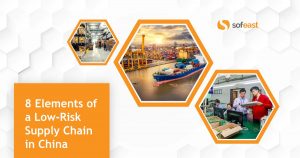As I have noted multiple times in the past, supply chain transparency, or at least the growing requirement for transparency, is a megatrend.
More and more, buyers will need to know who makes the critical components, where those factories are located, and collect some additional data about those sub-suppliers.
However, in the vast majority of cases, Chinese suppliers (and, to a lesser extent, those in Vietnam, too) do NOT want to disclose that supply chain information, mainly for 2 reasons:
- If the buyer can see the cost of the full bill of material, it becomes much easier to challenge the final price.
- In many cases, the final assembly factory can be replaced relatively easily, as long as the whole supply chain behind it still functions.
Let’s look at 3 approaches you may want to use to push a supplier to show more information and improve your supply chain transparency.
1. Point to your legal obligations (if applicable) as a must
You may not be forced to collect a lot of information about your supply chain, but you may be in that situation in a few years time. Let’s look at two recent developments that require importers to collect data way beyond their tier-1 suppliers:
Example 1: German Supply Chain Due Diligence Act
In summary, large importers will need to have a level of visibility throughout their supply chain. They will need to manage their social compliance & environmental risks. And they need to include the management of those risks in their management systems.
More countries will require this, in one form or another, I am sure.
I am sure that’s the future, at least in Europe. The European Commission is working on an EU-wide regulation that will also focus on human rights and on the environment.
Example 2: the UFLPA
Importers of China-made products need to pay attention to this if they sell on the US market. As part of the ongoing pissing contest, there is increasing pressure to block imports of products that come from a certain Western province of China.
Some American buyers have lost sleep over it, apparently, based on some calls we have been getting. They are looking for ways to get visibility into their tier-2, -3, -4 etc. suppliers, in order to collect evidence that the materials making up their product do NOT come from the sensitive area (be it cotton, rare earths used in battery cells, dried tomatoes, etc.).
And they are finding out that collecting that kind of evidence is really, really hard if they haven’t set their supply chain with that intent from the start.
Is China making it easier to have visibility into a product’s supply chain?
Not exactly.
There is hope that the corporate social credit system, once in place, makes some information public, but that remains to be seen. In the meantime, about 2 years ago, China decided they would no longer make their export data public, so that’s a move in the opposite direction.
And, as I noted not long ago, Chinese suppliers are not getting any more transparent or accountable in their daily practices.
In Vietnam, overall, the feedback from buyers is that they find it easier to get what they need when they purchase from certain types of manufacturers. Greater openness and more supply chain transparency are more likely there.
2. Show how much the situation will cost you
Let’s say your product needs electro-plating to be done very consistently in order to assure the product’s aesthetics and durability. If the thickness or the amount of certain materials is inconsistent, the resulting batch can lead to many customer complaints.
The approach we usually suggest is “let’s send an engineer to the plating factory, to confirm their process controls are great”. And, in certain cases, that works. We are invited in. We often find in the preparation, in the setup, and/or in the monitoring of the process that the plating factory has a list of points they need to improve on. They can be audited again on the next batch, to see if improvements are in place.
In other cases, though, we are not allowed to go into the main plating workshop(s). They think they are magicians and we might copy them.
And there are also cases where we (and our client) never know who & where the plating factory is. The supplier is afraid their customer might go around them and cut them out. That fear is not unfounded, as it has happened.
Now, what if an engineer can’t go on-site and confirm good process controls are in place? How can the importer confirm there are no risks of customer complaints?
They have to do a lot of testing (thickness measurement, reliability testing such as friction & perspiration, chemical analysis of the layers, and so forth) and it’s much more expensive.
Can the supplier provide do the tests themselves and provide their own reports? (Do they have the equipment?) If not, doing that in an external lab will be costly. Should the buyer pay for it entirely?
3. Do sourcing work and put suppliers in competition with one another
My last suggestion is… do more research and show that other suppliers accept your conditions.
It can work if you need lower pricing, better payment terms, the signature of your contract, or a bit more openness about sub-suppliers.
However, it also shows that you are “shopping around”, and some suppliers may behave in the opposite to your expectations. They might be afraid that you’ll take their prototypes, etc. to a competitor, and so might actually share less information with you. So, be careful here.
Closing remarks…
Finally, I will close with a note of caution about obtaining a more transparent supply chain. Your supplier doesn’t want to tell you much about your sub-suppliers. But the sub-suppliers also don’t want to share anything about sub-sub-suppliers. Mapping your full supply chain is often impossible.
Even if you start working on it when developing a new product and picking all the components, and even if you are gearing up to buy 100 million USD a year of that product, it will be extremely hard if your bill of material has more than 20 or 30 lines.
Make sure you start with a risk analysis and place a priority on the highest sources of risk. Don’t try to boil the ocean.
P.S.
There’s also a trend where importers want to avoid transparency when they face their own customers, too. Read here to learn how to keep your China factories’ identities secret.
8 Elements of a Low-Risk Supply Chain in China
This FREE webinar is related to better supply chain transparency and will empower you to transform your supply chain in China to reduce risks. Two industry experts, Renaud Anjoran and Paul Adams from Sofeast, talk you through how to gain control over your product’s quality, on-time shipments, long-term pricing stability, and continuity of supply.
Ready to watch? Register by hitting the button below:



